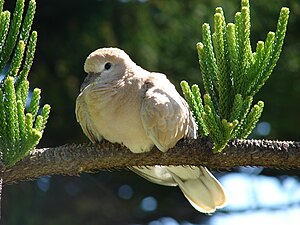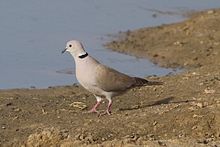North African laughing pigeon
| North African laughing pigeon | ||||||||||
|---|---|---|---|---|---|---|---|---|---|---|

Laughing dove |
||||||||||
| Systematics | ||||||||||
|
||||||||||
| Scientific name | ||||||||||
| Streptopelia roseogrisea | ||||||||||
| ( Sundevall , 1857) |
The North African Laughing Dove or Laughing Dove for short ( Streptopelia roseogrisea ) is a species of bird from the pigeon family (Columbidae). It inhabits the Sahel region in sub-Saharan Africa and the Arabian Peninsula.
Features and vocalizations
The North African laughing pigeon has a body length of 28 to 30 cm. The plumage is largely monochrome light beige on top. The wings and the base of the control springs are clearly contrasting dark brown-gray, the distal half of the second to sixth control springs are predominantly white. At the nape of the neck she wears a narrow black ribbon that extends forward to the middle of the neck. The neck and chest are also light beige, the belly and flanks almost white. The legs are red, the beak dark gray. Both sexes look the same. Overall, the species is very similar to the turkish pigeon , it is somewhat larger, overall somewhat darker, the wings are somewhat lighter and the belly is light beige.
The singing consists of a long, drawn out first syllable, a short pause, and then a sloping and slightly rolling syllable, something like koo, kurroo-ooh .
distribution and habitat
The range of the species covers the entire Sahel zone in Africa south of the Sahara from Mauritania to Somalia as well as the southwest of the Arabian Peninsula . She inhabits deserts and semi-deserts there .
Systematics
According to molecular genetic studies of the mitochondrial DNA (mtDNA) and the cell nucleus DNA, the closest relative of the North African laughing pigeon is the Turkish pigeon , these two species form the sister group of the spectacled pigeon .
The domesticated form of the North African laughing pigeon , which is also often referred to as the laughing pigeon , used to be part of a separate species (" Streptopelia risoria "). Today, however, it is only used as S. roseogrisea forma domestica for the North African laughing pigeon .
Existence and endangerment
There is no reliable information on the size of the world population or on population trends, but the species is common at least in parts of its range. It is therefore considered safe by the IUCN .
attitude
The North African laughing pigeon caught in the wild is rarely imported. The domesticated form of the laughing dove, on the other hand, has been kept and bred by lovers for a long time. It is believed that the first laughing pigeons were kept in India. In the 19th century in particular, it was used in many Central European households. Magicians also like to work with laughing pigeons, as the species can become very tame. In wild pigeon keeping, laughing pigeons are often used as nurse birds to raise other wild pigeons. Because of its ease of breeding and the relatively rapid succession of generations, it also plays a role in research as an experimental animal.
In the domesticated laughing pigeon, the predominant plumage color is a warm, light yellow-brown or isabel yellow. The throat, abdomen and under tail-covers are lightened. In addition, there is also an albinotic form in which the entire plumage is white, the beak is light flesh-colored and the iris and feet are red. Other color mutations are piebald, pink and isabel-colored domestic pigeons with a white neck. In the USA, so-called silky-feathered laughing pigeons have also been bred. The breeding of such mutations is controversial, as these pigeons are no longer able to fly and the sparse plumage does not protect the pigeons from lower temperatures.
swell
Individual evidence
- ↑ Distribution of the laughing dove on www.groms.de
- ^ KP Johnson, S. de Kort, K. Dinwoodey, AC Mateman, C. ten Cate, CM Lessells and DH Clayton: A molecular phylogeny of the dove genera Streptopelia and Columba. The Auk 118, Issue 4, 2001: pp. 874-887 full text as pdf
- ↑ Rösler, p. 131
- ↑ Münst, p. 132 and p. 133
- ↑ Rösler, p. 132
- ↑ Rösler, p. 131
literature
- David Gibbs, Eustace Barnes and John Cox: Pigeons and Doves - A Guide to the Pigeons and Doves of the World . Pica Press, Sussex 2001, ISBN 90-74345-26-3 .
- Alois Münst and Josef Wolters: Tauben - The species of wild pigeons , 2nd expanded and revised edition, Verlag Karin Wolters, Bottrop 1999, ISBN 3-9801504-9-6 .
- Gerhard Rösler: The wild pigeons of the earth - free living, keeping and breeding . M. & H. Schaper Verlag, Alfeld-Hannover 1996, ISBN 3-7944-0184-0 .
- Lars Svensson , Peter J. Grant, Killian Mullarney, Dan Zetterström: The new cosmos bird guide. Kosmos, Stuttgart 1999, ISBN 3-440-07720-9 , pp. 382 and 390.
Web links
- Streptopelia roseogrisea in the endangered Red List species the IUCN 2008. Posted by: BirdLife International, 2008. Accessed on 2 November, 2008.
- Videos, photos and sound recordings on Streptopelia roseogrisea in the Internet Bird Collection
- Photos of the laughing dove on www.birdsoman.com

